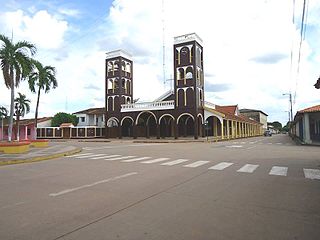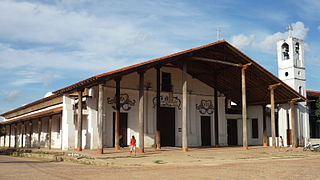
Trinidad, officially La Santísima Trinidad, is a city in Bolivia, capital of the department of Beni. The population is 130,000. While historically a peripheral city in Bolivia, Trinidad is today an important center for the Bolivian Bovine industry and has enjoyed a modest economic boom in recent years and enjoys an HDI index of above 0.700.

Belisario Boeto is a province in the Bolivian department of Chuquisaca.

Tomina is a province in the Chuquisaca Department in Bolivia. Its seat is Padilla.

Yamparáez is a province in the Bolivian department of Chuquisaca. It is divided in two sections: first section with head in the town of Tarabuco, and the second section with its head in Yamparáez.
Yuracaré is an endangered language isolate of central Bolivia in Cochabamba and Beni departments spoken by the Yuracaré people.
Itonama is a moribund or extinct language isolate once spoken by the Itonama people in the Amazonian lowlands of north-eastern Bolivia. It was spoken on the Itonomas River and Lake in Beni Department.
The Uru language, more specifically known as Iru-Itu, and Uchumataqu, is an extinct language formerly spoken by the Uru people. In 2004, it had 2 remaining native speakers out of an ethnic group of 140 people in the La Paz Department, Bolivia near Lake Titicaca, the rest having shifted to Aymara and Spanish. The language is close enough to the Chipaya language to sometimes be considered a dialect of that language.
Bauré is an endangered Arawakan language spoken by only 40 of the thousand Baure people of the Beni Department of northwest of Magdalena, Bolivia. Some Bible portions have been translated into Bauré. Most speakers have been shifting to Spanish.
Loreto is a smalI municipality in the Beni Department in northern Bolivia, capital of the Marbán Province and Loreto Municipality. In 2001, Loreto had a population of 843.

Santa Ana del Yacuma is a town in the Beni Department in north-eastern Bolivia.

San Ignacio de Moxos is a town in the Beni Department of northern Bolivia.
Moxo is any of the Arawakan languages spoken by the Moxo people of the Llanos de Moxos in northeastern Bolivia. The two extant languages of the Moxo people, Trinitario and Ignaciano, are as distinct from one another as they are from neighboring Arawakan languages. The extinct Magiana was also distinct.

San Joaquín is a small agricultural town in the Beni Department in the Bolivian lowlands.

Municipality Municipality is the first municipal section of Hernando Siles Province in the Chuquisaca Department in Bolivia. Its seat is Monteagudo.
Chimoré Municipality is the fourth municipal section of the Carrasco Province in the Cochabamba Department, Bolivia. Its seat is Chimoré.
Pojo Municipality is the second municipal section of the Carrasco Province in the Cochabamba Department, Bolivia. Its seat is Pojo.
Puerto Villarroel Municipality is the fifth municipal section of the Carrasco Province in the Cochabamba Department, Bolivia. Its seat is Puerto Villarroel.
Entre Ríos Municipality is the sixth municipal section of the Carrasco Province in the Cochabamba Department in central Bolivia. Its seat Entre Ríos had 3,796 inhabitants at the time of census 2001.
Guarayu is a Tupian language of Bolivia that is spoken by the Guarayo people who number 23,910 in 2012.








